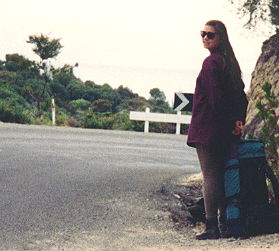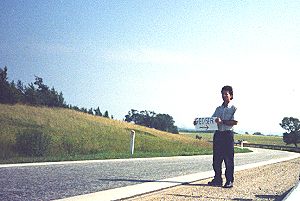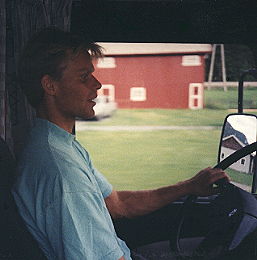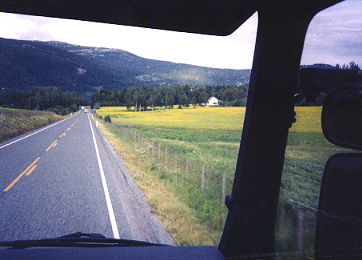Chapter 13
Hitchhiking
I love to sail forbidden seas and land on barbarous
coasts. Herman Melville, USA
Experience
Risk Analysis Countries
Women Signs
Literature Etiquette
Mitfahrzentralen
Epiphany
Tips
EXPERIENCED HITCHHIKERS WITH thousands of miles and hundreds of rides
behind them--and with sharp heads on their shoulders--don't accept rides from strangers
trivially. You could be killed, injured, robbed, and/or raped.
Around Sydney a serial killer had been preying on hitchhikers for several
years, with seven known deaths. The victims were Australian, German, and British, all
between the ages of nineteen and twenty-one. The police fear more because when a
backpacker disappears no one knows for a long time.
These young people didn't perish because they were naÔve or their intuition was faulty,
but because they opened the door of a car driven by a murderer who knew what he was doing
and looked like anyone else. (There was a conviction for these crimes in 1995.)
LESS TRAGICALLY, hitchhiking may not get you where you're going when you want to get there.
You may not have the patience to wait hours or days for a ride, or walk the
miles and miles a hitchhiker must accept as part of the game. You may not like standing in
the rain, in the cold, in blazing heat. For these reasons the vast majority of travel
backpackers rely on public transportation and never hitch rides.
Nevertheless many people do hitchhike, every day, all over the world. Indeed in some
places it's more or less a daily routine of life. Even I growing up in a small Ohio River town
occasionally hitchhiked to high school. I had missed the bus, it was too cold
to ride my bike, or the car wasn't starting--and
all these people were driving by where I needed to go. Before long I would have a
lift and ten minutes later I'd be dropped off. I didn't think much about it.
In further out parts of the world where buses don't often run and personal
transportation is rare, hitchhiking is standard public transport. In some
cases signaling systems have evolved to tell drivers how far you're going, or if you're
willing to pay for gas.
And on summer mornings in Europe it's not unusual to see a dozen backpackers waiting at
a good spot outside a major city. Many are not there solely to save money (it
can work out costlier than public transport when food, accommodation, and time
are factored), but because they love to hitchhike.
I am one of those people. Indeed hitchhiking has contributed to my world
view that our planet is largely composed of good and friendly people. And while I cannot
advocate hitchhiking for anyone, in some places the risk of violence is moderate, and the
benefits can be great.
 |
Photo: Hitchhikers' most beloved car,
the CitroŽn 2CV. If one passes you by it's full, a local, or you're having
an invisible day. |
In this age what hitchhikers see and do and learn may not make headlines, but on a
personal level their achievements are impressive. Hitchhiking is travel by
the seat of one's pants--it takes guts and creative thinking. Hitchhikers have no mission
control to ask advice and no alternate switches to switch. Backup systems are feet and
possibly a tiny umbrella.
For me, hitchhiking is travel at its most fascinating. I usually feel I hardly know a
country until I've stood by one of its roads and waited for someone to give me a ride.
Hitchhiking is also great sport, replete with a roller coaster of emotion. When you get a
good ride, interesting conversation, or an invitation for tea to meet the family,
hitchhiking can be refreshing. On the other hand sometimes it stinks--badly.
Hitchhiking Risk Analysis and Assessment
Since the #1 threat to travelers is from motor vehicle accidents (mortality
calculated in Chapter 9 as one in one-hundred for Americans in America,
greater for debilitating injury), it is
reasonable that:
- Riding up to a dozen times per day with drivers of unknown sobriety in
vehicles of unknown safety
- Hours or days of standing and walking alongside many tons per second of
poorly controlled momentum in areas not designed for pedestrians
- Exposure to abused souls who would assault, rape, and murder
- Exposure to the elements
- In conjunction with normal human error
will significantly increase risk of death and injury for hitchhikers.
Where Hitchhikers Hitch
Hitchhiking by travel backpackers is relatively common in Europe, Australia, New
Zealand, and Canada. Most veteran hitchhikers consider the U.S. one of the worst countries
for hitching, except for Alaska and Hawaii where it's excellent. I will add that rural
Texas is obliging--they always think your truck is broke down.
The north of England, Scotland, and Wales are very good. In Poland the first car or
horse-drawn cart that can stop usually stops, and the hospitality is usually great.
While hitchhikers raise about as much compassion in France and Spain as the average
telephone pole, your odds of getting a lift are still much better than the average
telephone pole. (Now those guys...) I must give an extra star to France, however, since
it's the one country where women drivers would regularly pick me up.
Hitchhikers quickly cover vast distances in Germany once they get to
service centers on the autobahn. The trick is getting there in the first
place. Hitchhiking in Italy, while exciting, is dangerous since about one Italian
driver in five is actively seeking a meeting with God.
While few Japanese hitchhike in Japan, many westerners do because of the high cost of
transport. Japanese stop right away because they think something must be wrong. New
Zealand is nearly crawling with German and English hitchhikers, with a few Maoris
sprinkled in to keep it interesting. Australia is good, but the distances are so vast you
might end up with the same ride for days. Truckers are your best bet there.
The trouble with Ireland is--and all serious hitchhikers agree--it's too
feckin' easy!
Note to Women Hitchhikers
Women must be aware solo hitchhiking is the least safe of all options. Yes, mostly you
can get away with it, but odds for trouble skyrocket. A whole new subset of drivers will
stop for solo women who usually whiz on by a man, a man and a woman, or two women. These
include ax murderers, rapists, robbers, and general sleazeballs. (To be fair, some female
drivers only stop for female hitchhikers.)
I have seen this subset while hitching with women and sitting out of sight.
Cars screech to a halt or circle around, leering, toothless drivers checking the scene.
They zoom on after catching sight of me, dreams of easy sex thwarted. Of course, the
greatest threat to hitchhikers is the driver who looks like any other, but has evil or
stupidity at his core.
My Irish friend Maureen had some experience hitchhiking in Ireland, where she
considered it safe. Traveling on the continent for the first time, she didn't want to be
constrained by "sexist" thinking about hitchhiking, so she occasionally thumbed
a ride.
On her last solo ride in Poland she climbed into a van with a group of
other hitchhikers, thinking she would be safe with them. Gradually the others
were dropped off until only she remained. The driver turned off the highway
onto a back road. Night was falling, and she
had an uneasy feeling. Then he pulled over, nothing but forest
around for a long way.
He began looking at her significantly and motioning to the back of the van.
Panicking, and thinking how stupid she was for being there, she grabbed her pack
and tried to get
out. The driver also grabbed the pack but said no, it was okay. He restarted the van and they went on
without further event.
Maureen considers herself lucky, and says she will never again hitchhike alone. She
wanted to make clear, however, that her solo journey around Europe, and especially Poland,
was one of the best experiences of her life.
| Photo: Kiss up to Batgirl and you'll get
there fast! |
 |
Hitchhiking Signs
There is a decades-old controversy among hitchhikers about whether signs are a help, a
hindrance, or a waste in stopping speeding automobiles, and even what type of sign works
best. I am of the school that advocates signs as powerful travel tools.
I carry a large magic marker and notebook for sign-making. Sometimes I use the back of a map
for a big sign, or a found piece of cardboard. I firmly believe a well-made sign
will occasionally convince an ordinarily merciless driver to pull over. He reads the destination city,
say BOPO, and thinks, "Hey, I'm going to BOPO," and his foot instinctively goes
to the brake.
That is the theory. In practice the foot usually returns to the accelerator as senses
are regained. Members of the lazy camp contend almost no one will stop who doesn't
normally stop, so it isn't worth the effort to make signs.1
It is true that most rides come from a core of regular stoppers, many of whom are
former or current hitchhikers. There are, however, some drivers who stop occasionally,
plus those majority of drivers who still require education in the pleasures of picking up
strangers and taking them places. Every one of those rides is not only good for
you, but good for all hitchhikers. (Assuming you're half-way pleasant to be around, that
is.)
| The
very clever or less industrious
may find greater success with message signs. Instead of a destination, these
communicate something that
can be used over and over. Examples are: GOING MY WAY? and the classic, I
DON'T STINK. The idea is to create a smile and an acknowledgment of your humanity, which,
by the way, is a challenge at the on-ramp of a superhighway. |
 |
Making Signs
Whenever possible I use the big magic marker to make big, bold, beautiful signs that
are readable from two or three seconds drive-time away. A big sign may give the driver a
crucial extra second to stop. The only canvas I usually have, however, is my notebook,
so most of my signs are not big, bold, or beautiful.
I normally don't use far-away destinations (like PRAGUE from Paris), but shoot for a
closer destination en route. Then if the driver offers to go further, I have that
choice. On the other hand if you go for the whole shebang, you just might get it.
There's a lot to think about in sign-making, which is okay--you'll have the time.
Another trick is to use the native spelling of a city, such as KÝbenhavn for
Copenhagen, Athina for Athens, La La for Los Angeles, etc. Many drivers naturally prefer
riders who speak their native language.
A border makes the sign stand out. Look like you have somewhere to go, and that you
really want a ride. Finally, be nice when they don't stop--they probably have good reason.
For interesting reading check the light posts and road signs where hitchhikers
traditionally ply their craft. Scrawled there will likely be a poem or
message to you,
the future hitcher, from some rhapsodic or desperate soul from long ago. Hitchhikers exude
inspiration, and there is nothing between you and it but time.
Sadly, many fade away as sun and weather take their toll. But new ones take their
place, and new ones after that, as wave after wave thumb down the roads of glory.
If you are standing there reading this, God has forsaken you, and you are going to
die a slow, agonizing death from exhaust fumes, hunger, and indifference. Seen
near Oxford, England
You have entered the Twilight Zone. You can never leave here. Do Do Do Do Do Do Do.
Seen near Leeds, England
You poor dumb suckers, if I had to wait as long as you I'd have already thrown
myself in front of a cement truck. Seen near Amsterdam
 |
Photo: Thanks for the fast ride, man! (Driver races
this cherry Fiat on weekends.) |
USA-style hitchhiking employs a thumb pointed positively into the air or jauntily in
the desired direction of travel. Yes, this has a beauty and simplicity all its own and, as
an American, I'm proud to stick out my thumb anywhere in the world. But mostly I want a
ride sooner rather than never, so it pays to hitch as the locals do.
In some countries you casually hold out an open palm or a few fingers, or
even flap your hand like a little bird wing. In other places only eye contact is
required. Nearly everywhere women hitchhikers need only to find some shade, sit
on their packs, and try to work in a postcard before a Mercedes screeches to a halt.
There is one important worldwide hitchhiking rule, though. If dropped where there are
already one or more hitchers, do not be so bold as to think you can take a position at the
front of the line just because that's where you were let out. No way, Josť. Proper
etiquette insists you take a position twenty yards behind the last hitchhiker
already there.
Of course this doesn't necessarily mean you will be last to get a ride. If you reel one
in by virtue of your pleasant smile, superb sign, or huge thumb, it's yours, baby. That
guy ahead could be badly jinxed for any number of reasons.
Gallant hitchhikers, however--and there are many--inquire of their driver if there
might also be room for the poor sunburnt chap up the road. For some guys on some days it's
their only freaking chance!
These are ride-sharing companies, usually run by students or young people, found in the
bigger cities of Germany and Austria. Drivers inform them of destination and
departure time. You pay the mitfahrzentralen about
$10 in advance for this information, and the driver $10 to $25 for gas, depending on distance.
If the ride doesn't work out, your money is refunded. Sometimes their numbers are
listed in guide books--otherwise look up "mitfahrzentralen" in the phone book.
Similar companies are called Allostop in France, and are available in many cities
across Europe. Also check noticeboards around hostels, universities, and student cafes for
rides. These are good ways of traveling cheaply without hitchhiking.
After mind-numbing immobile hours (perhaps days) in central Greece (on
the E75 south of LŠrisa, scattered
hitchhiker remains foggily recalled), I finally came to realize that stern,
side-to-side shakes of the head by truck drivers roughly translates from Greek to:
"Jump in, dude. The door ain't locked!" Time to destination
thereafter
greatly improved.
Hitchhiking Tips
- Mortality
- I believe the greatest danger is from being run over. Always be on the
alert, watch every car carefully, don't stand in the road, never stand with
your back to the traffic, and be aware some motorists most of the time and
all motorists some of the time have poor vision and/or attention, and may
pull or swerve off the road onto you. Have a safety area in mind, and be
prepared to dash there.
- Choose
- your take-off spot carefully. A common hitchhiking mistake is looking for a ride
where most of the traffic is local or heading elsewhere, when a superior
site is a
short distance away.
- Inquire at hostels or among locals for tried-and-true hitching spots. Consult a detailed
map to determine traffic patterns. I often find it faster and safer to take a bus or train
a short distance away from major cities.
- The slower the better
- Hitch from intersections, gas stations, toll booths, and roadside stops where
automobiles stop or slow down. This gives the driver a few extra seconds to look over you
and the traffic situation. It is difficult and dangerous to stop a car going more than
fifty mph.
- Think for the driver
- A competent hitchhiker must think for the driver. You are asking him to make a maneuver
he doesn't regularly make, and other drivers around and behind may not expect.
- No ride is worth risking an accident. All good, traditional hitching spots have a safe
place for cars to pull over.
- Legality
- Hitchhiking directly on major highways is usually illegal and dangerous. It's better
anyway at roadside stops, at the beginning (or before the beginning) of on-ramps, and on
smaller roads.
- Standard Procedure
- When a car stops, first ask the driver where he's going. Then it's easy to decline the
ride if you don't like the smell of his breath, or if something doesn't feel right.
- Suspicious but desperate
- If the driver looks suspicious but you're so desperate you get in anyway, make sure the
door opens from the inside, stay next to the door, and never get between two men.
(Anywhere among four fun-loving Swedish girls in a Volvo is probably worth the
risk.)
- Instincts
- A driver with evil intent may indicate something is wrong before a confrontation begins.
Trust your instincts and get out. Say you've been sick all day and are about to
throw up. Don't encourage or tolerate inappropriate behavior.
-
- Risks vary
- Many people and cultures still have inhuman attitudes toward women.
- Combinations
- The best hitchhiking combinations for safety and getting rides, in order, are: a woman
and a man; two women; a lone man; and two men. Three is slow but not impossible for short
periods.
- Travel light
- If you have a lot stack it behind your biggest bag. There is usually room, and usually
the driver doesn't mind the inconvenience, but sometimes he does.
- Courtesy
- When a car stops don't make the driver wait. But before opening the door ask where he's going
and take a good look at him. Hitchhikers often politely turn down rides because they
aren't going far enough, or for other reasons. You never have to get in.
- Seat belts
- Always wear a seat belt and shoulder harness. Put it on immediately so there isn't an
awkward moment later when driving proficiency becomes apparent. If he drives
unreasonably, ask to be dropped off.
- Two-way street.
- Drivers stop for two main reasons: they genuinely want to assist the traveler, and they
may be looking for interesting conversation.
- Reality
- While hitchhiking is mostly great fun with friendly people, be aware of, and prepare
for, real risks.
Travelers' Tips
It's nice to offer to pay for gas. Most of the time they tell you not to
worry about it and when you do pay it's minimal. AJ
*
When hitchhiking across Germany, a good map that indicates autobahn service centers
and roadside stops is invaluable. Have the driver drop you at one of these, instead of an
exit, since they are by far the best hitching spots. Also, the first few letters on German
license plates indicate where the driver is going about half the time. Jason,
San Marcos, Texas
*
Always carry a flashlight when hitching or walking at night. In rural areas when
the moon isn't out, man, does it get dark! Les, Waco, Texas
*
Summer hitchhiking in the extreme latitudes is great. It doesn't get dark until
midnight, and then not very, so you've got plenty of time to get where you're going, and
everyone is in a cheery mood. Turbo, USA
*
As a woman I get rides quickly, but turn many down. When I do accept, I always
insist on keeping my pack on my lap, no matter how hot or uncomfortable or safe the driver
seems. If you must get out quickly, the last thing you want is to have to get the
trunk or back door open. Elly, USA
How to See the World is copyright © John Gregory 1995-2009. All rights reserved. Except
for personal use like showing to a friend, it may not be reproduced, retransmitted,
rewritten, altered, or framed. All
product names and trademarks are property of their respective
owners. Comment.
Sales.
Disclaimer. Thank you.
............
.
|
|
. |
. |
....... .
. |
.. |
.. |
. |
.`
|
| ....... |
:)
. |
. |
. |
..... |
.. |
.. |
. |
. |
| . |
. |
|
. |
. |
. |
|
. |
. |
| . |
|
. |
. |
...............
. |
. |
. |
|
. |
| |
. |
. |
. |
......................................... . |
. |
. |
. |
|
| ......
.............. |
. |
. |
. |
ARTOFTRAVEL.COM
.
|
. |
|
(: |
..
.
.
......... . |
| . |
. |
. |
. |
. |
. |
. |
. |
. |
Notes
1. About five percent of hitchhikers belong to a wildly proud third
group which never
makes signs and only rarely holds out a hand. Wherever let out they immediately stride on
down the road in vainglorious confidence someone will pull over without being asked. While
many claim great success, I believe they in fact suffer a high casualty rate. back





